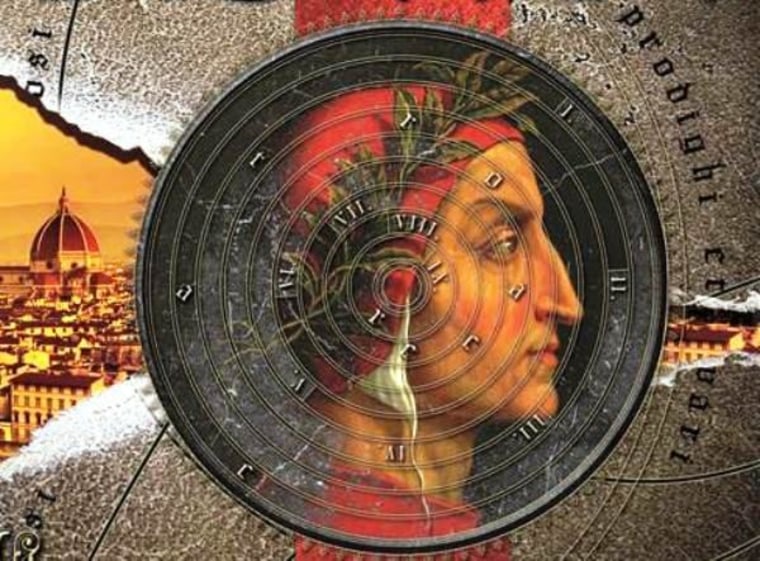Dan Brown's "Inferno," the latest thriller from the author of "The Da Vinci Code," is another globe-trotting, world-saving adventure — and a chance for readers to ponder a new set of mathematical and scientific puzzles.
In "The Da Vinci Code," Robert Langdon, the world's best-known fictional symbolologist, follows a trail that highlights a controversial reading of the relationship between Jesus and Mary Magdalene. In "Angels and Demons," an antimatter bomb from Europe's CERN research center plays a key part in the plot. In "The Lost Symbol," Langdon teams up with a researcher in noetic science, which tackles woo-woo subjects like ESP and vibrational energies. All three thrillers are seasoned with a healthy dose of secret codes.
"Inferno," released Tuesday, sticks with the classic recipe: The novel's opening scenes are set in Florence, an Italian city with a history as convoluted as its street map. Dante's Divine Comedy provides literary and artistic allusions — and lots of numerological clues for Langdon.
The Italian poet Dante Alighieri was, if anything, more of a numbers freak than Dan Brown: Who else would write a three-book masterwork consisting entirely of three-line stanzas? Each book is divided into 33 cantos — plus an extra one in Dante's Inferno, to make 100 cantos in all. The verses are riddled with references to threes, sevens, nines and other numbers with mystical meanings.

Numerological puzzles
Numbers and codes have played a part as well in the buildup to Tuesday's release of "Inferno." Even the publication date is a puzzle: Greg Taylor, author of "Inside Dan Brown's Inferno," noticed that if you reverse the American date notation, 5-14-13, you come up with the first five digits of pi (3.1415). Brown's publishers later confirmed that the date was chosen for just that reason.
Other clues are hidden in the book cover. (Minor spoilers ahead, so code junkies may want to skip to the next paragraph.) The letters CATROACCR are printed within nine concentric circles overlaid on a portrait of Dante, for example. Cipher fans figured out that the letters could be decoded to spell "Tesoretto," which may (or may not) refer to a small secret room in Florence's Palazzo Vecchio. The cover of the Italian edition displays a different string of letters, CATROVACER, which readers have interpreted as an anagram for CERCATROVA. "Cerca Trova" is Italian for "Seek [and] find" — a phrase that pops up in the first chapter of "Inferno." The phrase also shows up in a mysterious Florentine painting by Giorgio Vasari, a writer and artist who created a famous portrait of Dante. Circles within circles!
Michael Haag, author of a forthcoming guide titled "Inferno Decoded," says it's not surprising that Brown was so taken with numbers, codes and arcane connections. "Dan Brown was brought up in a highly academic background," he told NBC News. "His father's a mathematician whose books are standard works if you're studying math in the United States."
Scientific puzzlers
Dan Brown's fans will be puzzling over a few new scientific allusions as well. One theme has to do with the possibility of unleashing a devastating plague. Haag said that hearkens back to the "Black Death" that swept over Florence in 1348, a quarter-century after Dante's death. "This brought about total desolation, although some people have argued that the plague was actually a boost to the Renaissance," Haag said. Such people say all that death cleared the way for the prosperity and enlightenment that followed.
That sounds like just the sort of argument you'll hear the bad guys using in "Inferno."
Another theme focuses on transhumanism, a movement that aims to enhance humans through genetics, smart drugs, implants and other technologies. Some see transhumanism as the best hope for our species' survival. Others, like historian Francis Fukuyama, regard the concept as one of the world's most dangerous ideas. And that makes it one of the world's most fitting ideas for a Dan Brown thriller, particularly one that's set in Florence.
"During the Renaissance, what happened in Florence was the birth of humanism, so transhumanism is several stages up from that," Haag noted. "It's a potentially fascist activity, because it could lead to the creation of supermen. Who's going to do it? Are we all going to do it, or just some of us?"
Will Dan Brown's latest page-turner actually get people thinking about the real and serious issues surrounding emerging diseases and the potential for bioterrorism, genetic manipulation, human enhancement and bioethics? That sounds like a cliffhanger to me. Feel free to weigh in with your comments below.
More about Dan Brown:
Alan Boyle is NBCNews.com's science editor. Connect with the Cosmic Log community by "liking" the NBC News Science Facebook page, following @b0yle on Twitter and adding the Cosmic Log page to your Google+ presence. To keep up with NBCNews.com's stories about science and space, sign up for the Tech & Science newsletter, delivered to your email in-box every weekday. You can also check out "The Case for Pluto," my book about the controversial dwarf planet and the search for new worlds.